#us vogue 1988
Photo
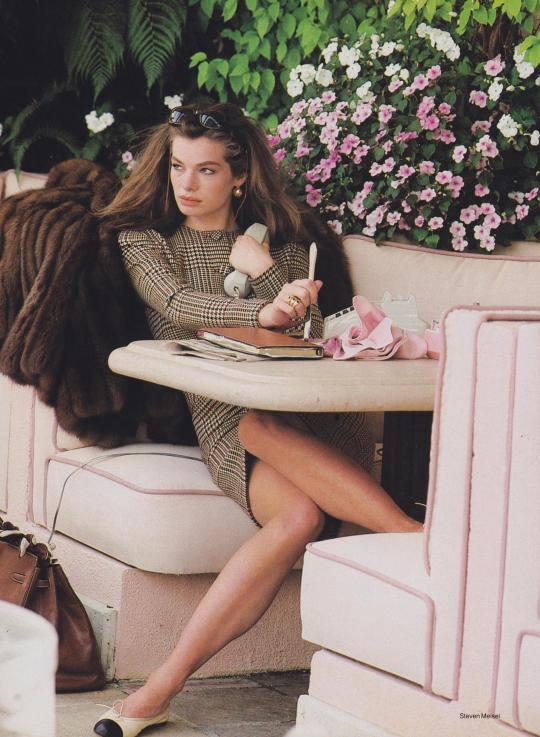
Cordula Reyer photographed by Steven Meisel for American Vogue, July 1988.
#cordula reyer#steven meisel#american vogue#vogue us#vogue#1988#fashion photography#photo shoot#fashion#photography#1980s
440 notes
·
View notes
Text
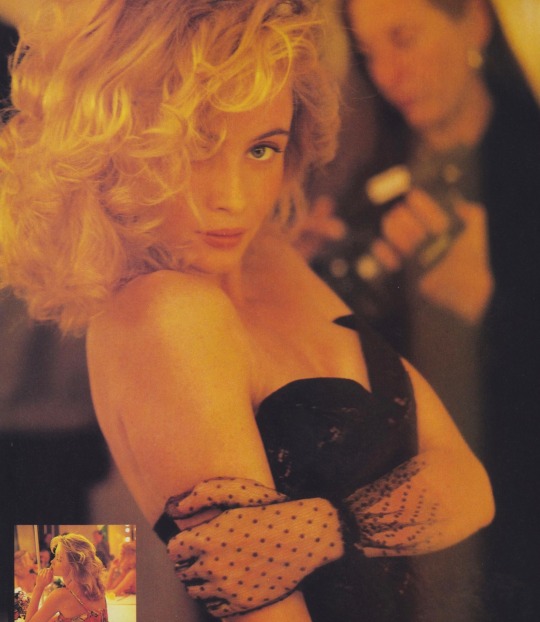
Emmanuelle Beart by Hans Feurer
- US Vogue, May 1988
33 notes
·
View notes
Text

US Vogue July 1988
Cordula Reyer is wearing a plaid suit and a woolen coat. By Valentino. Scarf, Chanel, gloves, Prada, suitcases, Louis Vuitton, tights, La Leg, boots at Emporium Capwell.
Hairstyle, Oribe, make-up Laura Mercier.
Cordula Reyer porte un tailleur à carreaux et un manteau en laine. Par Valentino. Écharpe, Chanel, gants, Prada, valises, Louis Vuitton, collants, La Leg, bottines chez Emporium Capwell.
Coiffure, Oribe, maquillage Laura Mercier.
Photo Steven Meisel
vogue archive
#us vogue#july 1988#fashion 80s#1988#fall#automne#valentino#chanel#prada#louis vuitton#la leg#emporium capwell#oribe#laura mercier#cordula reyer#steven meisel#plaid suit#tailleur à carreaux
43 notes
·
View notes
Photo
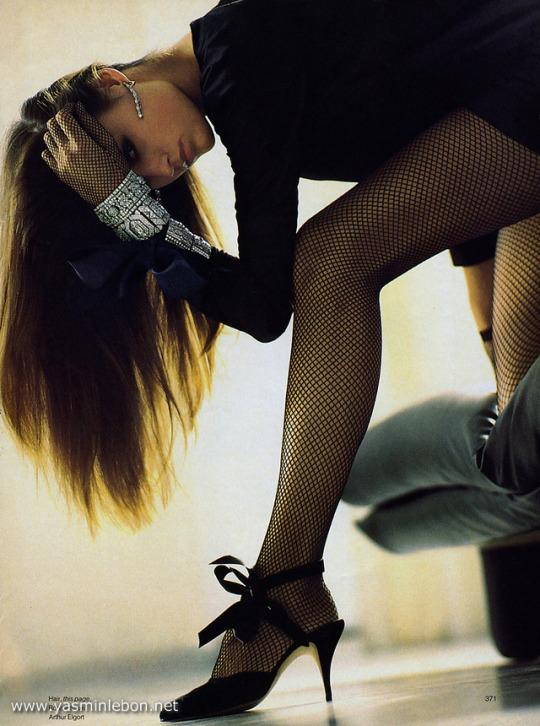
World Class Travelers | Vogue US febrero 1988
Yasmin Le Bon ~ Foto: Arthur Elgort
#Arthur Elgort#Yasmin Le Bon#Vogue US#1980s#Editorial#Fashion#1988#Supermodelos#Vogue US febrero 1988#World Class Travelers (vus 02/1988)#Mis cosas
51 notes
·
View notes
Photo

Toryorlando91:
Christy Turlington photographed by Irving Penn - Vogue April 1988
3 notes
·
View notes
Text
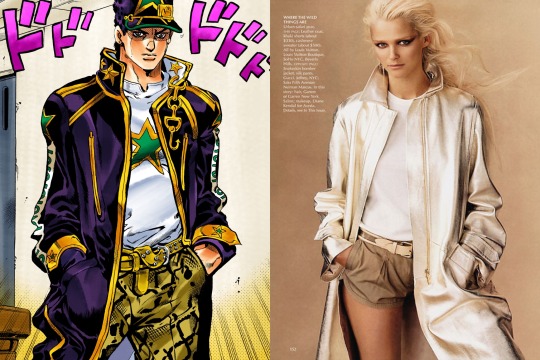




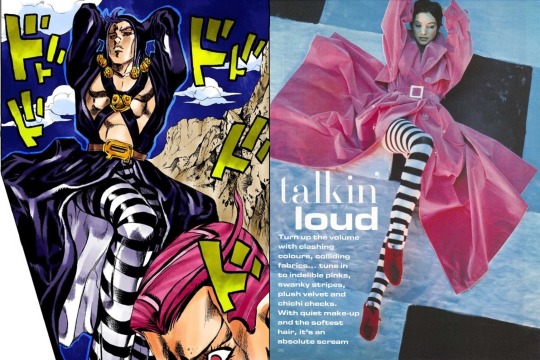
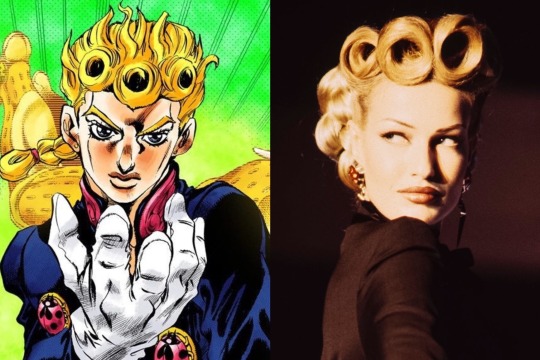

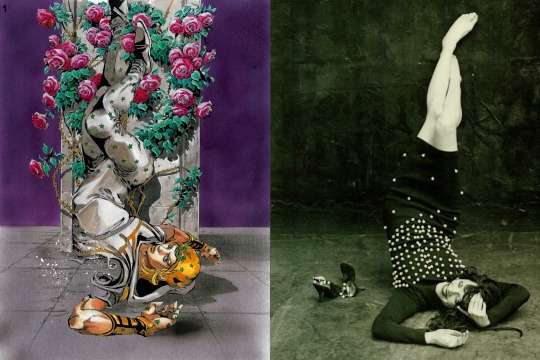

Hirohiko Araki's art references from fashion brands for Jojo's Bizarre Adventure
Left to right:
Jojo's Bizarre Adventure February 2000 / Vogue US January 2000
JBA October 2000 / Dior Spring 2000
JBA May 1995 / Versace AW 1984
JBA December 1999 / Vogue Italia September 1999
JBA July 1993 / Versace 1992
JBA March 1998 / British Vogue September 1992
JBA March 1997 / Mugler SS 1993
JBA October 2008 / V Magazine Fall 2007
JBA March 2008 / Vogue Italia November 1988
JBA December 1996 / Versace Fall 1995
#jojos bizarre adventure#hirohiko araki#jojo#jojo meme#anime#manga#weekly shonen jump#art reference#high fashion#fashion#vogue#v magazine#dior#versace#mugler#photoshoot#photography#pose#jojo pose#fashion archive#art archive#art#archive#aesthetic#fashion aesthetic#archive page#art trends#fashion blogger#photography trends#outfit
3K notes
·
View notes
Text
TOKYO BABYLON FST: BOX
what's poppin TyoBabi fandom, I got a present for you

.zip File Download:
DISCS 1 & 2 (109MB)

This FST is basically an in-depth run down of the collection of songs that were sung/mentioned/in the "VOL. 7/BOX" chapter of Tokyo Babylon 5, with some info about the artists and songs themselves. This, as far as I know, is the most thorough run-through of the music of "BOX" on the English web! I've divided it into two "discs", the first being the songs mentioned themselves, and the second being a few fun related extras. You can check out the second disc over on Radio Free T.Y.O, if you're interested ♥
Ginza no Koi no Monogatari

銀座の恋の物語 - "Ginza Love Story"
石原裕次郎・牧村旬子 - Ishihara Yuujirou and Makimura Junko
mp3 download || youtube
The song that Seishirou and Hokuto are pouring their very souls into to perform in the beginning of the chapter. Released in 1961, this a smoky, jazzy duet typical of its time, telling the story of two star-crossed lovers, one in Tokyo and one in Ginza. It was an immediate hit, even having a movie based upon it made, starring Ishihara-san in the lead role. It's a staple duet in karaoke even to this day.
Nakanaide

泣かないで - "Don't Cry"
舘ひろし - Tachi Hiroshi
mp3 download || youtube
The song that the random selector spits up for Subaru to sing, which Sei-chan subsequently picks up after sending him off to buy cigarettes/exorcise the OL. This was released in 1984, by Tachi Hiroshi, a singer and actor who became quite the sensation when he had a starring role in 西部警察 (Seibu Keisatsu; "Western Police") -- incidentally, directed by the abovementioned Ishihara-san, as you'd have it. "Nakanaide" was a hit, coming in 59th on the ORICON's 1984 top singles list. It's from his seventh album In the Mood.
Nanpasen

難破船 - "Shipwreck"
中森明菜 - Nakamori Akina
m4a download || youtube
The song that the OL ghost sings. A dark and heartfelt song about a dying love, it was a massive hit when it was released in 1987, shooting straight to the top of the ORICON charts (as Nakamori-san's 17th number one hit), and has been a karaoke regular since then, just as the OL says in the chapter. Originally written and performed by the very respected Kato Tokiko for her 最後のダンスパーティ (Saigo no Dance Party; "Last Dance Party") album of 1984; she personally requested that Nakamori-san perform the song. It's been covered countless times, including by the original singer/songwriter and the cover artist themselves.
Daite...

抱いて… - "Hold Me..."
松田聖子 - Matsuda Seiko
mp3 download || youtube
Not actually sung, but the OL ghost suggests she'd like to sing it next. A dramatic and emotional slice of idol pop from the Eternal Idol herself, Matsuda Seiko (who also performs "Who's That Boy", found on Single White). Released in 1987 as a promo-only single from her fifteenth studio album, 1988's Citron. Despite never being released as an official single, it's one of Matsuda's more popular songs, especially karaoke-wise. It's rather interesting that the OL picks a Matsuda song directly after a Nakamori Akina track -- the pair were notorious rivals in the 80s, supposedly even in love.
Benkyo no Uta

勉强の歌 - "Study Song"
森高千里 - Moritaka Chisato
mp3 download || youtube
The song Hokuto is singing when Subaru attempts to sneak back into the karaoke box. Released in 1991, it peaked at #4 on the ORICON charts, and was remixed on Moritaka's second remix album as ザ・勉強の歌 (Za・Benkyo no Uta; "The・Study Song"). It was used as the opening theme to the anime TV series "Mischievous Twins: The Tales of St. Clare's". It's a totally gimmicky song (complete with voguing in the very weird video clip), though cheerful and catchy, so its popularity on the karaoke circuit at the time shouldn't surprise anyone. (You just know that Hokuto unironically adored this song, and drove Subaru batty by singing it at every opportunity.)
Wakaretemo Suki na Hito

別れても好きな人 - "Beloved Even if We're Separated"
ロス・インディオス&シルヴィア - Los Indios & Silvia
mp3 download || youtube
The song that Hokuto announces Subaru should sing with Seishirou as punishment for being late. Another staple in the duets section of karaoke, still, this 1979 release was actually a cover. The song was released by two Toshiba EMI artists, Matsudaira Kemeko and the Purple Shadows, respectively, in 1969. In October 1975, Los Indios released a single-voice version, and in 1979 it was rearranged as a male and female duet, with some lyrics changed slightly. The song was an instant hit, and by 1980, it had sold a million copies.
#Tokyo Babylon#TyoBabi#subaru sumeragi#hokuto sumeragi#seishirou sakurazuka#x1999#clamp#seisub#tokyo babylon music#fst#fan soundtrack#fanmix
191 notes
·
View notes
Text
Between 1984 and 1986, the number of liposuction operations rose 78 percent—but the procedure barely worked. Liposuction removed only one to two pounds of fat, had no mitigating effect on the unseemly "dimpling" effect of cellulite, and, in fact, often made it worse. The procedure also could produce permanent bagginess in the skin and edema, just two of the "variations from the ideal" that the plastic surgery society cataloged in its own report. Another "variation" on the list: "pain."
Furthermore, the plastic surgery society's survey of its members turned up several other unfortunate incidents. A liposuction patient lay down to have stomach fat removed and woke up with a perforated bowel and fecal matter leaking through the abdominal cavity. Three patients developed pulmonary infections and two had massive infections. Three suffered pulmonary fat embolism syndrome, a life-threatening condition in which fat can lodge in the heart, lungs, and eyes. And "numerous patients" required, as the survey delicately put it, "unplanned transfusions." On March 30, 1987, Patsy Howell died of massive infections three days after a liposuction operation performed by Dr. Hugo Ramirez, a gynecologist who ran a plastic surgery clinic in Pasadena, Texas. The same day Howell had her operation, Ramirez performed liposuction on Patricia Rogers; she also developed massive infections, was hospitalized in critical condition, and eventually had to have all her skin from below her chest to the top of her thighs removed.
Howell, a thirty-nine-year-old floral shop manager and the mother of two sons, submitted to liposuction to remove a small paunch on her five-foot-one frame. She weighed only 120 pounds. “This literature she got at a shopping mall said the procedure was so simple,” her friend Rheba Downey told a reporter. “She said, ‘Why not?’” She made up her mind after reading Ramirez's newspaper ad, calling the surgery "the revolutionary technique for reduction of fat without dieting." No one told her about the dangers. Ramirez operated on more than two hundred women, causing numerous injuries and two deaths before his license was finally revoked.
By 1987, only five years after the fat-scraping technique was introduced in the United States, the plastic surgery society had counted eleven deaths from liposuction. A 1988 congressional subcommittee placed the death toll at twenty. And the figure is probably higher, because patients' families are often reluctant to report that the cause of death is this "vanity" procedure. A woman in San Francisco, for example, who was not on the surgery society's or Congress's list, died in 1989 from an infection caused by liposuction to her stomach; the infection spread to her brain, her lungs collapsed, and she finally had a massive stroke. But her family was too ashamed about the procedure to bring it to public attention.
The society's 1987 report on liposuction, however, seemed less concerned with safety than with "the reputation of suction lipectomy," which its authors feared had been "marred by avoidable deaths and preventable complications." It concluded that all problems with liposuction could be easily solved with "guidelines governing who is permitted to perform and advertise surgical procedures." In other words, just get rid of the gynecologists and dermatologists and leave the surgery to them.
Yet some of the liposuction patients had died at the hands of plastic surgeons. And the most common cause of death was the release of fat emboli into the heart, lungs, and brain—a risk whenever inner layers of epidermis are scraped, no matter how proficient the scraper. As even the report acknowledged: "[Liposuction] is by its nature a tissue-crush phenomenon. Therefore, fat embolism is a realistic possibility."
Surgeons also marketed the injection of liquid silicone straight into the face. Vogue described it this way: "Plastic surgery used to be a dramatic process, but new techniques now allow doctors to make smaller, sculptural facial changes." This "new" technique was actually an old practice that had been used by doctors in the last backlash era to expand breasts—and abandoned as too dangerous. It was no better the second time around; thousands of women who tried it developed severe facial pain, numbing, ulcerations, and hideous deformities. One Los Angeles plastic surgeon, Dr. Jack Startz, devastated the faces of hundreds of the two thousand women he injected with liquid silicone. He later committed suicide.
For the most part, these doctors were not operating on women who might actually benefit from plastic surgery. In fact, the number of reconstructive operations to aid burn victims and breast cancer patients declined in the late '80s. For many plastic surgeons, helping to boost women's self-esteem wasn't the main appeal of their profession. Despite the ads, the doctors were less interested in improving their patients' sense of "control" than they were in improving their own control over their patients. "To me," said plastic surgeon Kurt Wagner, who operated on his wife's physique nine times, "surgery is like being in the arena where decisions are made and no one can tell me what to do." Women under anesthesia don't talk back.
-Susan Faludi, Backlash: the Undeclared War Against American Women
92 notes
·
View notes
Note
Don’t wanna get too crazy here but with Karlie buying W and i-D… do you think she wants to be the next Anna Wintour? I don’t mean she wants to outright replace her once she retires but maybe she wants to follow a similar career trajectory?
I don’t think she wants to be Anna Wintour, though she respects her and there are a few similarities. Anna has been editor-in-chief of US Vogue since 1988, and is the chief content officer of Condé Nast.
Karlie is more of an investor and entrepreneur, and geared more to the business side of things but has a unique position and perspective given her career in fashion and actually working with these publications. That position offers priceless connections, insight, and experience in a fast changing industry. Her positive professional reputation amongst designers, photographers, editors, writers, makeup artists, investors etc is a big plus.
Whether Karlie decides to be part of the artistic direction of a publication, or the business side or something in between, its something she is very capable of doing and a great next step for her. She’s been quietly working towards this behind the scenes for a while now anyways.
Also, she has very much been ahead of the trends in digital and sustainable fashion technology. She’s been talking about it for years now and it’s slowly moving on that front, but she knows it’s coming which is a great thing to be able to get ahead of, and an important quality to have.

Honestly Karlie realized the importance of social media early on has and used it to promote her interests on a personal level. Also, she realized early on she had a curiosity for learning things outside of modeling and has pursued those interests with passion. (I feel that, given the vast amount of interests I have and need to learn something new constantly).
And as a model, she understands the power magazines have in fashion. I know a lot of publications are moving away from print and going digital for costs, and to be eco-friendly, but I think there’s still a market for physical copies, it just needs to be revamped for a comeback. Like vinyls.
So to answer your question, no I don’t think wants to be Anna Wintour… I think there’s big difference in their focuses, but yes I can see her have a similar trajectory but with a wider field of view.
Karlie is part of the next generation of publishing and all that it entails. She has a vision and a passion for so many different things and one thing publishing does is combine a lot of those things into one. So it’s a smart move for her and something I think she will be very good at and dive deeper into in the future. If she didn’t think she could turn something around I don’t think she’d invest. And there’s a personal connection there for her that is special.
When you hear her talk about these things, whether it’s the intricacies of the fashion world, or when it comes to business, or advocacy, she always has the facts and statistics on hand. I believe she’s being the change she wants to see, and taking a seat at a table where she (and other women) deserve to be 🤍
27 notes
·
View notes
Text
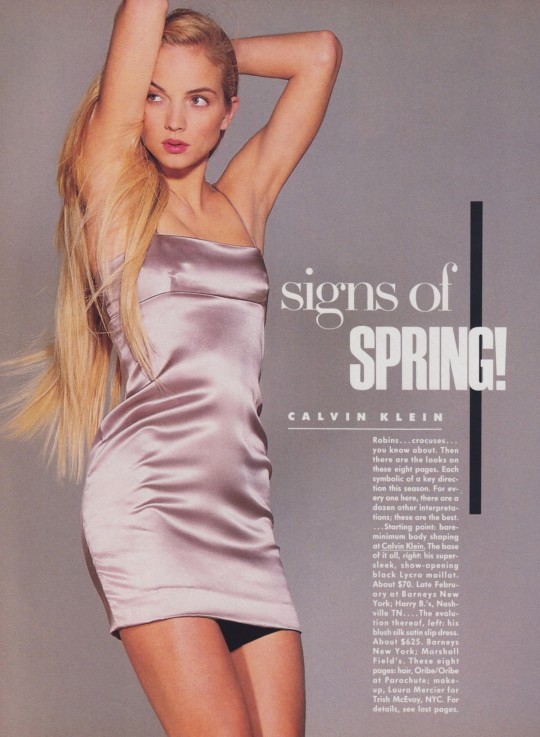

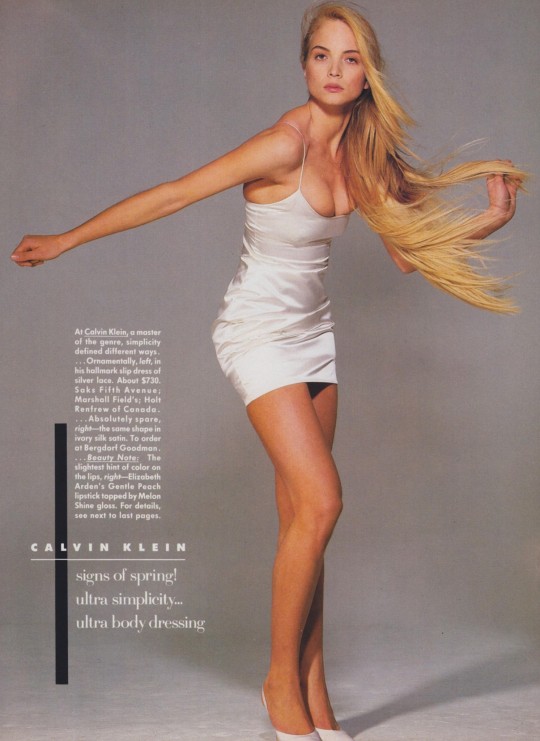

Signs of Spring! Rachel Williams by Steven Meisel for Vogue US, February 1988
#fashion#supermodel#vintage fashion#vogue#vogue us#vogue magazine#rachel williams#vogue editorial#editorial#fashion editorial#vintage 1980s#1980s fashion#1980s#1980s style
362 notes
·
View notes
Text

Emmanuelle Béart by Hans Feurer for US Vogue May 1988, "Beauty and Béart"
24 notes
·
View notes
Photo
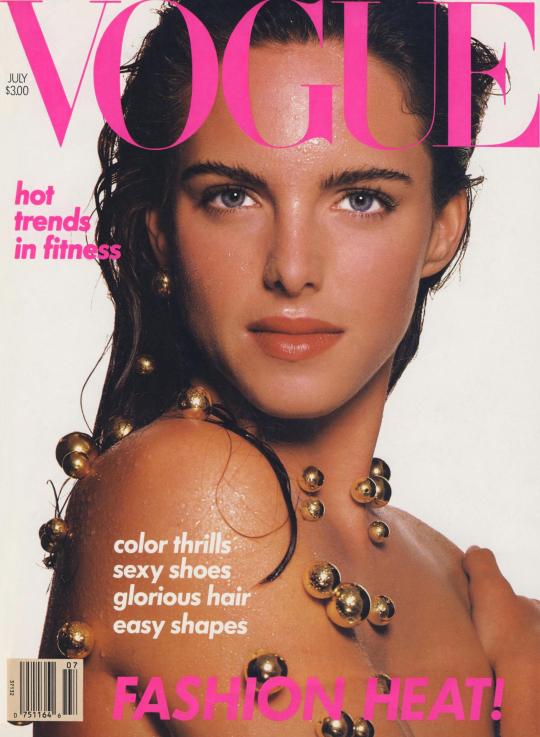
Susan Miner photographed by Richard Avedon on the cover of American Vogue, July 1988.
#susan miner#richard avedon#american vogue#vogue us#vogue#1988#fashion photography#photo shoot#fashion#beauty#1980s#vogue covers
21 notes
·
View notes
Text

Juliette Binoche by Bettina Rheims
- US Vogue, January 1988
16 notes
·
View notes
Text

US Vogue February 1988
Brynja Sverris wears a wool plaid jacket, wool pique pants and silk taffeta blouse. By Calvin Klein. A.Serbin earrings, skin gloves, Fownes.
Beauty note: Shiseido Golden Brown lipstick.
Brynja Sverris porte une veste à carreaux en laine, un pantalon en piqué de laine et blouse en taffetas de soie. Par Calvin Klein. Boucles d'oreilles A.Serbin, gants en peau, Fownes.
Note beauté : rouge à lèvres Golden Brown de Shiseido.
Photo Irving Penn
vogue archive
#us vogue#february 1988#fashion 80s#spring/summer#printemps/été#calvin klein#ready to wear#prêt à porter#brynja sverris#irving penn#shiseido#a.serbin#fownes
16 notes
·
View notes
Text

Juliette Binoche photographed by Bettina Rheims for US Vogue, January 1988
#1988#80s#1980s#black and white#actress#actor#model#magazine#photoshoot#fashion#style#famous#celebrity#hair#makeup#juliette binoche#vogue#vogue magazine
15 notes
·
View notes
Text
Paris is Burning: the Fabulous and the Ugly of Queer POCs in the Shadow of NYC
"Ball is like crossing into the looking glass, a wonderland. You go in there and you feel 100% right of being gay."

Directed by Jennie Livingston in 1990, Paris is Burning follows the Ballroom culture that originated in NYC, an underground LGBTQ+ subculture, where African-American, Latino gay men, and transgender folks "walk" in drag and attend performance competitions to win cash prizes and trophies in categories like “Face,” “Femme Queen Realness,” and "Voguing." In the 1980s of New York City, queer POCs were extremely ostracized due to their sexuality and race, they struggled in the dark ghetto of this metropolitan area, while the Ballroom community offered them a shelter to be their authentic selves. Most participants of Ballroom belong to groups known as "houses." Folks could choose their own "mother" and siblings who accept them and love them, for being gay. What's more, Voguing became queer POCs' distinct way of self-expression. Dancers act in different poses, with an emphasis on the movements of arms and body, just like the model on the cover page of the magazine Vogue. And it is all about confidence and self-love. In this sense, Ballroom became an identity celebration of the oppressed, the exiled, and the outcast, where queer folks of color find status, acceptance, and worth.

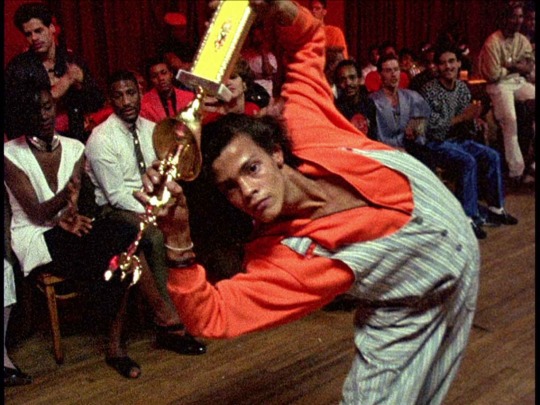
Regarding the documentary itself, I argue that Paris is Burning breaks into the mainstream media with its groundbreaking representation of black gays and trans people of color and its disclosure of the intersectional oppressions faced by queer POCs; however, the representation of "performance competitions" is still constrained in the frame of gender performativity, and the production of it is criticized as an appropriation of Ballroom culture by a privileged white filmmaker.
Here is a trailer to have an overview of this documentary.
youtube
Part 1: About Intersectionality
The biggest message Paris is Burning brings to the table is intersectionality, where it captures black gays and trans people of color as well as their subculture. Queer theory actively acknowledges the importance of queer of color critiques. That is, oppression on various aspects of identity intertwines and compounds together, such as sexuality, gender, race, age, class, and ableness. And each oppressive institution (racism, sexism, homophobia, transphobia, etc.) cannot be examined separately from one another. Queer folks of color are being ostracized and marginalized not only within larger society but also in the queer community, meaning that they face multiple oppressions. And it is true. A gay man of color in the documentary said, "I remember my dad used to say, 'you have three strikes against you in the world. You are black, a male, and you are gay; you are going to have a hard fuckin' time.'"
Tracing back the history of Ballroom culture, we also see the significance of intersectionality through its origin. Black and Latino drag queens used to experience racism in established drag queen pageant circuits. Although participants were racially integrated, the judges were almost all white. Since then, drag queens of color have begun to organize their own pageants, the Ball. In that case, Ball culture becomes a retrospective symbol of the era when queer people of color underwent discrimination from multiple sources.
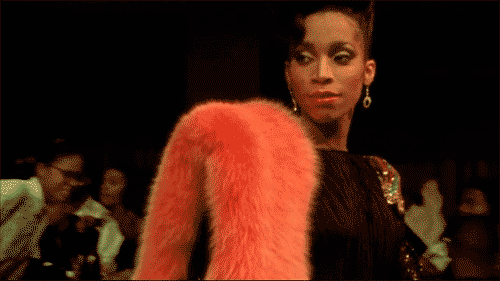
Venus Xtravaganza, a trans woman in the documentary, whose murder reveals the very dark and brutal side of intersectional oppression. Venus, an Italian-American, was saving up money for gender confirmation surgery while earning a living as a sex worker after she was excluded by her family. However, her dead body was found at a hotel on Christmas Day, 1988, during the documentary's shooting. But her killer was never found. In the documentary, she described the experience of being attacked by a man who discovered she was transgender during an intimate encounter. Hence, Xtravaganza's trans identity, multiraciality, homelessness, hustling, poor access to health care, and AIDS — all these aspects layered together contributed to the tragic end of this beautiful life.
Below is a clip about the self-narrative by Venus Xtravaganza.

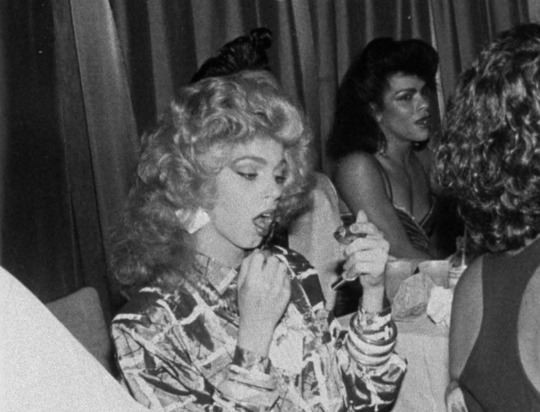
youtube
“The most profound and potentially the most radical politics come directly out of our own identity, as opposed to working to end somebody else's oppression" (Collective, 1983, p. 210). In other words, coping with oppression is inherently associated with identity politics, a deconstruction of identity and labels. What queer folks of color need are to be recognized as normal, equal, lively human beings.
Part 2: About Gender Performativity
It is undeniable that Paris is Burning is a milestone in portraying queer POCs, however, there are still some controversies. Firstly, the representation of "performance competition" still conforms to the tenet of gender performativity. To articulate that, we need to know the basic rules of competition in a given ball first. There are various "categories," or themes, for each competition, such as "Military," "School," "Executive Realness," "Butch Queen's First Time in Drag at a Ball," etc. And participants need to dress according to the guidelines of each category; for example, they wear “yacht wear," military garb, the outfits of private school kids, business attire, and extravagant dress to adhere to the rules.
Here is a clip from the documentary explaining "Categories."
youtube
Overall, we can see these queer POCs parody their heterosexual counterparts. It seems effortless for them to perform high femininity or masculinity in a world of heterosexual folks. However, these "categories" also signify that they are still in a dichotomous system and perform binary genders.
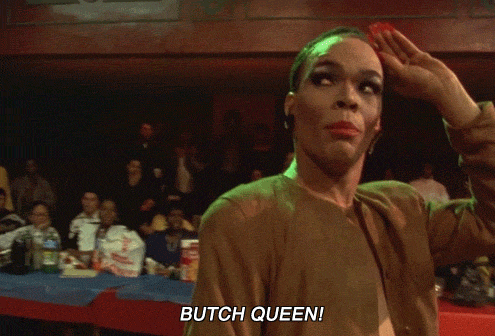

Another category called "high fashion evening wear" required participants to dress and act as an elegant, beautiful young lady wearing an evening dress. Every participant was strictly required to have a purse. "An evening bag is a must, you have to carry something; no lady is sure at night." This kind of "norm" reminds me of the gender performativity theory by Judith Butler: gender is not something we are but something we do. However, due to the reliance on norms, we "do" genders through imitative performance, ultimately leading to extended repetition. In other words, we have no authentic gender.
The voiceover of the documentary said, "The more natural you are, the more credit your outfit is given." "Give people a sense that they are not gay, like a real woman or a real man." However, what is "natural" and what is "real"? What is even a category? As Judith Butler has argued, "we cannot necessarily assume that binary biological sex everywhere provides the universal basis for the cultural categories ‘male’ and ‘female’. If gender constructs are culturally variable, then so are the categories of sexual difference" (cited in Andresson, 2002, p. 6).

Being different is not a flaw, which is the spirit of the queer community. Unfortunately, the documentary did not highlight how queer people of color get rid of the constraints of the binary system or how they go against the mainstream, which makes it less queer.
Part 3: About the Production
Much of the controversy surrounding Paris is Burning has also centered on the perceived appropriation of a black gay subculture by a privileged white queer filmmaker for profits. Jennie Livingston is an American director. She graduated from Yale University in 1983, where she studied photography, drawing, and painting with a minor in English literature. "Whiteness" and the social status of an "ivy student" are critical privileges for Livingston. What's more, she identified herself as a lesbian. It seems Linviston's queerness helps her to enter the industry and tell stories about black gays and trans people of color even though she is not a part of the Ball community.

It is not surprising that the filmmaker's white view leads to stereotypical depictions of black folks in the documentary. For example, the "Banjee" competition features impersonations of the gum-chewing, round-the-way sexy girl on welfare or the crackhead gangbanger on the block. Besides that, Dorian Corey, an experienced drag queen, said in the documentary: "Black stars are stigmatized. Nobody want to look like Lena Horn, everybody wanted to look like Marilyn Monroe." This scene amplifies the drag queen's self-hatred, solidifying the admiration for whiteness among drags. But this kind of representation is biased.
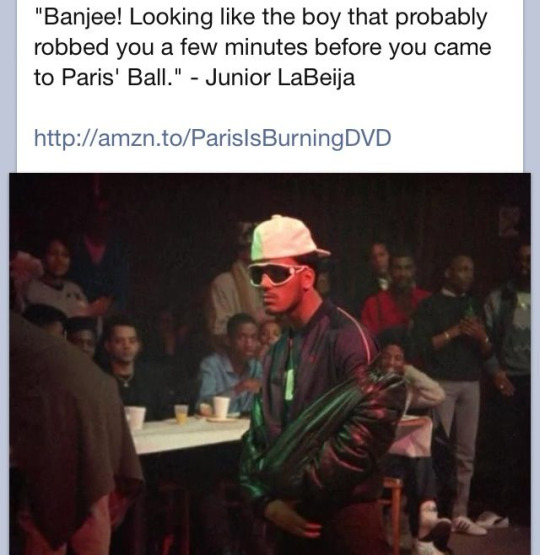
"Too often, people with resources who already have a platform become the ones to tell the stories of those at the margins rather than people who themselves belong to these communities" (Tourmaline, 2017). We need to strive for a time when queer people of color have the opportunity and capital to shoot their own stories. “Power struggles over control of one’s image and access to the tools of media production were, and still are, crucial in communities of color” (Parkerson, 2020). Although the show Pose has made some breakthroughs by hiring trans characters and trans writers, it is hard to make any substantial change in this inherently racist, heterosexual, white male-dominant industry.

Moreover, the film made 4 million dollars, yet only $55,000 was distributed among the 13 performers. Performers felt cheated and were not satisfied with their representation in the documentary. In 2014, when the documentary was to be screened at a public event hosted by Celebrate Brookly! / BRIC, a protest was raised. In such circumstances, Livingston would apologize for the cultural appropriation to her own advantage.
Here is a clip showing the life of performers after the Paris is Burning.
youtube
Final Thoughts
"Good or bad, Paris is Burning is a milestone in the gay community."
Considering my own subject positionality, as a straight, cisgender woman of color from China, I have to say that watching Paris is Burning is definitely a fascinating and eye-opening experience. Regardless of some of its biased representation, this documentary makes me take a glimpse of the Ballroom culture in NYC which has extended globally and influenced a lot of Chinese queer folks in recent years. I also get to know some drag queen shows becoming popular in underground clubs located in Shanghai and Beijing.
Meanwhile, I deeply resonate with this group of outcast New Yorkers, for whom racism, poverty, and homophobia are too real, too tough, while they create a world of sustenance and belongingness by themselves. It is all about the power they give to themselves. In the name of glory and pride, they dance, scream, suffer, survive, and most importantly, be themselves here. Ballroom culture makes them not stay in the shadow of NYC, but throw the shadow on those who demean them. All in all, Paris is Burning is the "fire this time."
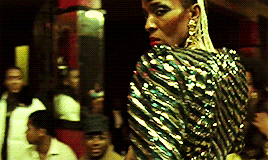
References:
Andersson, Y (2002). “Queer Media?: Or; What Has Queer Theory to do with Media Studies?” IAMCR, 1-10.
Collective, C. R. (1983). The Combahee river collective statement. Home girls: A Black feminist anthology, 1, 264-274.
Martin, A. L. (2018, August 2nd). Pose(r): Ryan Murphy, Trans and Queer of Color Labor, and the Politics of Representation. LA Review of Books. https://lareviewofbooks.org/article/poser-ryan-murphy-trans-queer-color-labor-politics-representation/
Parkerson, M. (2020, February 25th). Paris Is Burning: The Fire This Time. The Criteron Collection. https://www.criterion.com/current/posts/6832-paris-is-burning-the-fire-this-time
By Selene
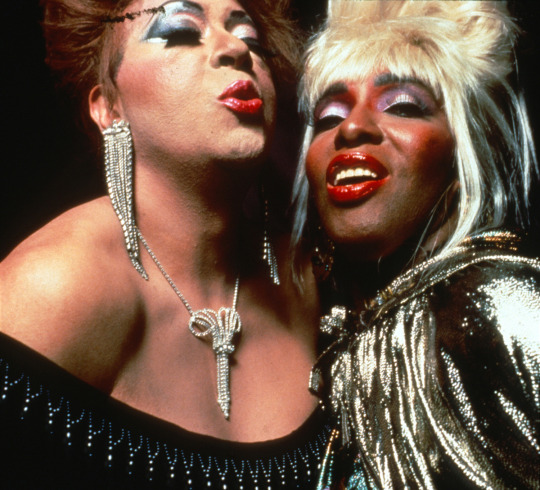
#queer media#queer film#queer studies#paris is burning#ballroom#nyc#voguing#documentary#lgbtq#lgbtq+#drag queen#Youtube#ball culture#drag#transgender#gay rights#gay movement#intersectionality#gay movie#movie review
127 notes
·
View notes